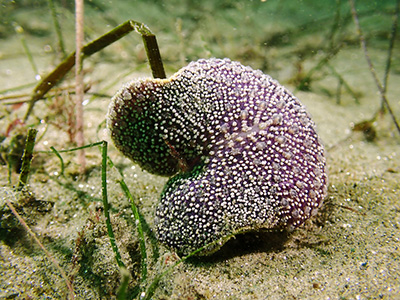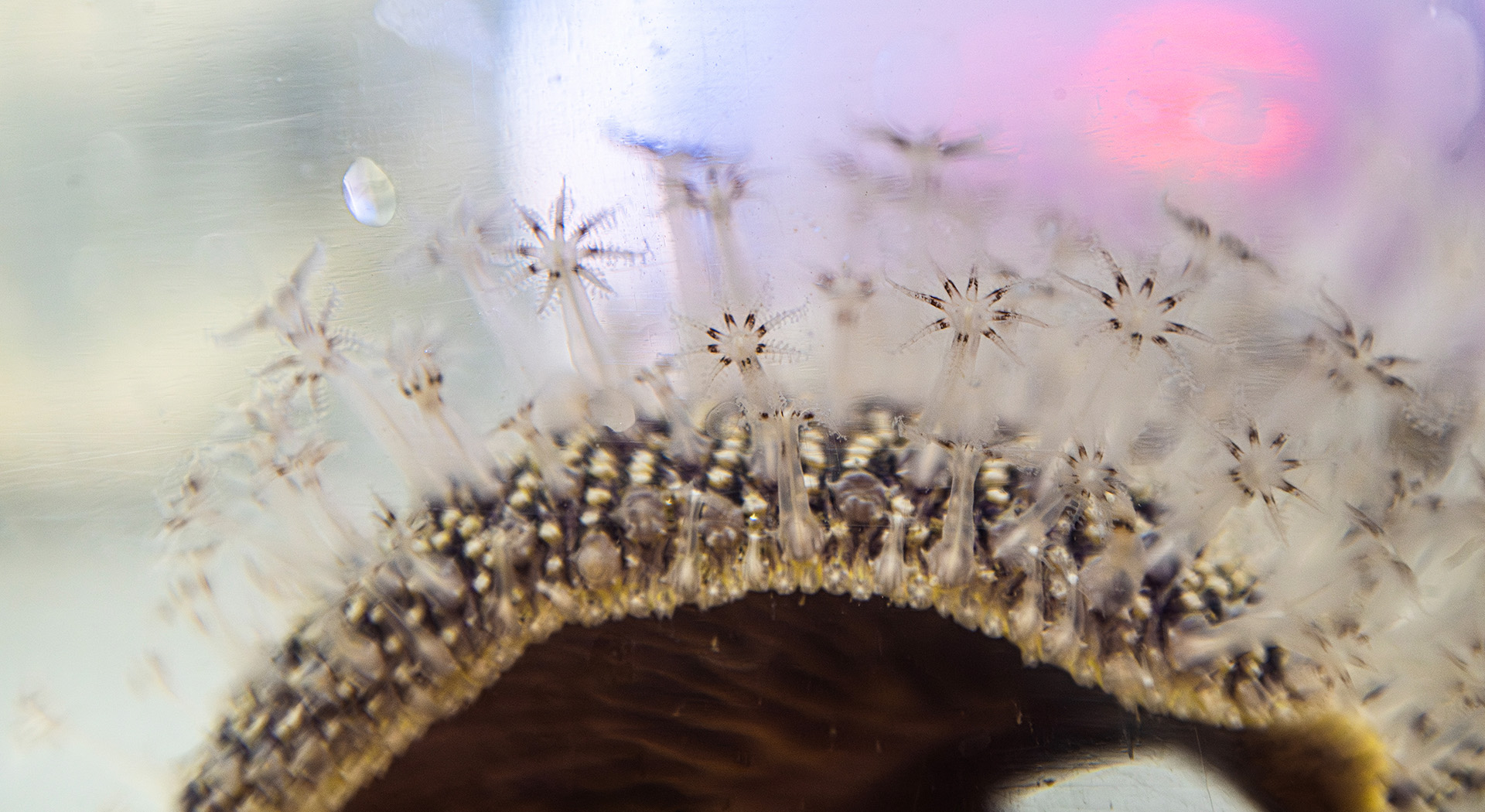Study Unlocks Soft Corals’ Biomedical Potential
Researchers uncover the genetic blueprint for coral chemicals with anti-cancer and anti-inflammatory properties
Published Date
Story by:
Media contact:
Share This:
Article Content
Some corals produce chemicals called diterpenoids that have shown promise in fighting cancer and reducing inflammation, but researchers have been unable to study the chemicals in depth.
The problem is that the chemicals are produced in tiny amounts by slow-growing and uncommon corals, making it environmentally destructive and impractical to supply enough of the compounds to test or produce new drugs.
Now, a new study led by scientists at UC San Diego’s Scripps Institution of Oceanography may finally unlock these corals’ chemical potential. The study found a cluster of five genes responsible for the production of diterpenoids across multiple species of a type of coral called octocorals. Discovering this gene cluster enables biochemists to produce the octocoral compounds in the lab and investigate their potential as medicines or other products. The research, published today in Nature Chemical Biology, was supported by grants from the National Institutes of Health (NIH), the National Science Foundation and NOAA.

“Corals produce unique chemical compounds not seen in the terrestrial world, so there is lots of excitement to study their biomedical potential,” said Bradley Moore, the study’s senior author and a marine chemist with joint appointments at Scripps Oceanography, where he is the director of the Center for Marine Biotechnology and Biomedicine, and UC San Diego’s Skaggs School of Pharmacy and Pharmaceutical Sciences. “Unfortunately, it is super challenging to get enough supply directly from nature. With the genetic blueprint for producing these chemicals now in hand, the door is open to solve the supply issue and discover new compounds that could benefit humankind.”

Scouring the oceans for biomedical utility among the myriad chemicals produced by marine life is a focus of Moore’s research. A similar search has been going on for nearly a century on land – roughly half of all medicines come from terrestrial nature — but the ocean has yet to be studied as thoroughly despite covering 70% of Earth’s surface. Moore’s joint appointment at Scripps Oceanography and Skaggs School of Pharmacy illustrates UC San Diego’s unique ability to explore the ocean’s potential by combining cutting-edge marine science and world-class biomedical research.
Octocorals are an ancient group of animals that includes soft corals and sea pens. Compared to their reef-forming cousins, octocorals are soft bodied and lack the physical defense of a hard skeleton. To avoid being eaten, scientists think octocorals use chemical defenses that include diterpenoids, which are also widely used by plants to ward off herbivores and for a variety of other biological functions. Plant diterpenoids have been the basis of numerous important medicines — most notably the billion-dollar anti-cancer drug taxol, which comes from the Pacific yew tree and has been administered to millions of patients to slow tumor growth. Octocoral diterpenoids have shown anti-cancer and anti-inflammatory properties as well, but have chemical structures unlike anything seen on land, making them exciting prospects.
“Picking through an organism's entire genome to find all the genes involved in the production of a particular compound is an incredibly daunting task — especially when we may not even know which genes we’re looking for,” said Natalie Grayson, a Ph.D. candidate at Scripps and first author of the study. Finding all the genes an organism uses to code for the production of a given chemical matters because it allows researchers to insert those genes into microbes such as yeasts, which serve as living chemical factories to produce larger quantities of the chemical in the lab. If those genes are clustered together, finding them is much easier.
In 2022, the study authors made a surprising discovery: A species of octocoral commonly known as a sea pansy (Renilla muelleri) produced diterpenoids and appeared to do it with genes located close together in its genome.
In the current study, the researchers set out to prove that octocorals cluster the genes related to diterpenoid production. With the help of automated equipment donated to Scripps Oceanography by the biotechnology company Illumina, the team analyzed octocorals from across the globe representing five families — including a species of sea pansy collected just off Scripps Pier — that all produce a similar diterpenoid.
The team started by sequencing and assembling the genomes of five octocoral species. By exploring those five genomes as well as those of three other species that were publicly available, the researchers were able to identify a common set of five genes clustered together that appeared to be involved in diterpenoid production.
To test whether this gene cluster was actually related to making the compounds, the researchers inserted the genes into yeast and bacteria and then analyzed the chemicals the microbes produced. The results confirmed that the clustered genes were indeed the genetic assembly line for these unique chemicals.
“Finding these gene clusters gives us as scientists all the knowledge we need to synthesize these chemicals and makes discovering new drugs or products practical,” said Moore. “This can finally address the supply issue that’s held back exploration of coral biochemistry.”

Next, Moore’s lab plans to insert the gene clusters they discovered in these octocorals into microbes to produce larger quantities of the diterpenoids for further study. This ability to synthesize the compounds in the lab also allows researchers mining marine biochemistry to tread more lightly on the planet by requiring fewer samples from the deep.
The exciting possibilities for new medicines or useful products based on the unique chemicals produced by marine life underscore the importance of ocean conservation, said Grayson.
“Nature is the best chemist,” said Grayson, who connects with the ocean through surfing and diving as well as her research. “We are only so creative, and we need a healthy ocean if we want to keep discovering this kind of novel chemistry that has evolved over millions and billions of years.”
Moore also emphasized the importance of the government support that enabled this research and basic science more broadly.
“This is a perfect example of NIH funding basic science with the potential to benefit humankind,” said Moore. “If we want the best medicines to support our health, then we need as many shots on goal as possible. Understanding the tricks ancient animals like octocorals use to survive and applying that to human health could be huge, but it could take five or 10 years to translate. That’s way too risky for a private company to invest in. Federal support is essential to this kind of work that does not have a quick payoff but also has huge potential upside.”
In addition to Grayson and Moore, the study was co-authored by Immo Burkhardt of Scripps Oceanography as well as Malia Moore and Todd Michael, who both have appointments at Scripps Oceanography and the Salk Institute for Biological Studies. The study’s co-authors from other institutions are Tyler Alioto of the University of Barcelona and Spain’s National Center of Genomic Analysis, Jessica Gomez-Garrido of the University of Barcelona and Spain’s National Center of Genomic Analysis, Jean-Baptiste Ledoux of the University of Porto, and Paul Scesa and Eric Schmidt of the University of Utah.
“This is a perfect example of NIH funding basic science with the potential to benefit humankind. If we want the best medicines to support our health, then we need as many shots on goal as possible. Understanding the tricks ancient animals like octocorals use to survive and applying that to human health could be huge, but it could take five or 10 years to translate. That’s way too risky for a private company to invest in. Federal support is essential to this kind of work that does not have a quick payoff but also has huge potential upside.”
Share This:
Stay in the Know
Keep up with all the latest from UC San Diego. Subscribe to the newsletter today.





